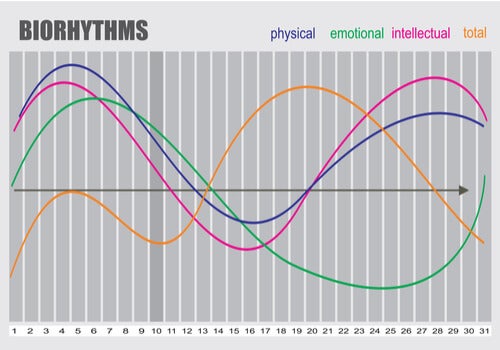What Circadian Rhythms Are and How They Work

Circadian rhythms are responsible for maintaining a body balance and their base is light and darkness. All living beings have oscillatory functions, 24 hours a day. However, these change according to the light and the season of a given place on the planet.
A biological rhythm is a regular variation of an organic function related to the course of time. There are different types of biological rhythms according to the biological variations of time: circadian, infradian, and ultradian.
Thus, circadian rhythms refer to those that take place all day long. Infradian rhythms are those whose regular variations record over a period longer than 24/7. Meanwhile, the ultradian rhythm refers to the variations registered during a period of fewer than 24 hours.
How do circadian rhythms work?
The first to use the term circadian rhythm was Dr. Franz Halberg. Etymologically, it means “cycle close to 24 hours”. However, some authors consider this cycle actually fluctuates between 24 and 25. The organization of the circadian system contains:
- A visual component integrated by photoreceptors.
- Pacemaker structures that generate the circadian signal.
- Efferent pathways from the pacemakers to the effector systems.
The suprachiasmatic nucleus is in charge of receiving all the information about the environment. Furthermore, it receives information directly from the luminosity of the environment through the nerves.
The pineal gland is another structure of great importance when it comes to circadian rhythms. It secretes melatonin, which regulates these along with other physiological processes.

Circadian rhythms
Each part mentioned above has a function:
- The suprachiasmatic nucleus interacts in stages of sleep or in certain processes when awake. This nucleus receives information about the brightness of the exterior through the hypothalamic retinohypothalamic nerves. These act as a circadian clock responsible for the sleep-wake cycle. The light must be recaptured by photosensitive ganglion cells in the retina in order to generate this action. Thus, it transforms into nerve impulses that reach the SCN.
- The location of the pineal gland is in the epithalamus between the two superior quadrigeminal tubercles. This gland receives information about light from the environment via:
- The visual pathway (SCN).
- Descending autonomic projections to the cervical intermediate column (superior cervical sympathetic ganglia).
- Postganglionic pineal sympathetic innervation.
This gland synthesizes melatonin, which influences the regulation of the neuroendocrine system and regulates circadian rhythms and other physiological processes. Moreover, the variation of light and darkness in melatonin synthesis is the essential fact that explains the involvement of the gland.
Thus, the physiology of biological rhythms melatonin opens the gates of sleep with the goal of inhibiting the wake-promoting activity of the suprachiasmatic nucleus.
Historical aspects
Since ancient times, people have tried to adhere to the schedules set by the Earth’s rotation. This is why human beings conduct their activities during the day and reserve the night hours for rest. This changed thanks to the appearance of the incandescent lamp, making nightlife possible.
The rhythms of biological processes began to be described in the 18th century. However, it wasn’t until 1959 that researchers began to describe circadian rhythms. Thus, a new biological discipline called chronobiology arose in 1960 and medical chronobiology appeared 11 years later.
Later on, in 2007, the World Health Organization (WHO) and the International Agency for Research on Cancer (IARC) determined that circadian rhythm disruption could be a cause of cancer in humans.

It seems that changes in the circadian rhythm determine a pattern that needs correction in order to avoid certain alterations of the body such as:
- Digestive
- Cardiovascular
- Sleep
- Adrenaline synthesis
- Behavioral
- Hormonal activity
The influence of melatonin and biological rhythms on homeostasis needs further investigation. Furthermore, chronobiology, chronopharmacology, and chronotoxicology are some of the areas of science that investigate circadian rhythms and their activity in the human body. This often sheds light on diseases such as cancer. This is why it’s so important to continue to consider how circadian rhythms affect the human life cycle.
All cited sources were thoroughly reviewed by our team to ensure their quality, reliability, currency, and validity. The bibliography of this article was considered reliable and of academic or scientific accuracy.
-
Torres, J. S. S., Cerón, L. F. Z., Amézquita, C. A. N., & López, J. A. V. (2013). Ritmo circadiano: el reloj maestro. Alteraciones que comprometen el estado de sueño y vigilia en el área de la salud. Morfolia, 5(3).
-
Dvorkin, M., & Cardinali, D. (2003). Best&Taylor Bases Fisiológicas de la práctica Médica. Décimo tercera edición en español. Madrid España. Editorial Medica Panamericana.
-
Martínez, G. (2009). Regulación circadiana del comportamiento: diferencias entre especies diurnas y nocturnas. Universitas Psychologica, 8(2), 487-496.
-
Ángeles-Castellanos, M., Rodriguez, K., Salgado, R., & Escobar, C. (2007). Cronobiología médica. Fisiología y fisiopatología de los ritmos biológicos. Rev Fac Med UNAM, 50(6), 238-41.
-
Sigurdardottir, L. G., Valdimarsdottir, U. A., Fall, K., Rider, J. R., Lockley, S. W., Schernhammer, E., & Mucci, L. A. (2012). Circadian disruption, sleep loss, and prostate cancer risk: a systematic review of epidemiologic studies. Cancer Epidemiology and Prevention Biomarkers, 21(7), 1002-1011.
This text is provided for informational purposes only and does not replace consultation with a professional. If in doubt, consult your specialist.








